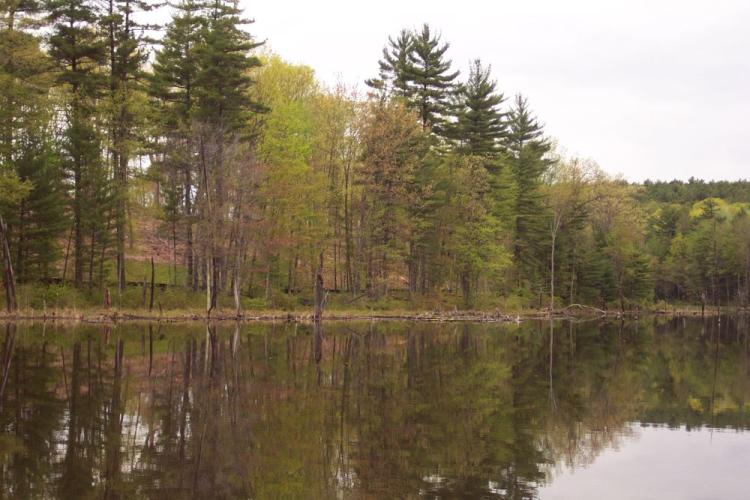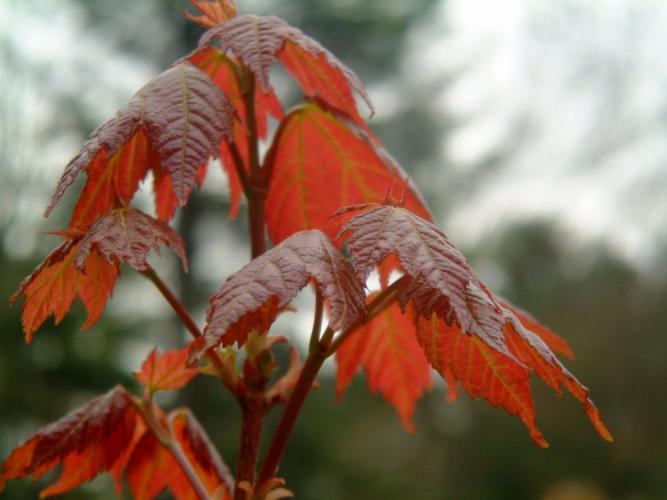Nature's View
- Tags:
- Nature's View

Spring foliage is as magical as it is ephemeral. Hardwood buds burst into tiny flowers, and tender leaves unfold at the Forest Society’s Champlain Forest Reservation in Rochester. Photo Tom Howe.
The less we are able to admit common feelings into our relationship with trees, the more impoverished we become: it must indicate a deforestation of the spirit. Strangely enough, their least understood qualities lie in the sensate natures they share with the rest of life… We have hardly started to explore our mutual chemistry.
- John Hay, The Immortal Wilderness, 1987.
It’s possible that one day soon, the land conservation community will quantify the importance of our work protecting forests, farms, wildlife habitats, and urban parks in terms of human health and sociological benefits as much as the more traditional natural resource values conserved. Recent studies reveal how even brief periods of immersion in natural surroundings positively impact human hormone cycles that regulate our response to stress.
A research study at the University of Edinburgh, Scotland monitored daily circadian fluctuations in the hormone cortisol. Scottish researcher Catharine Ward Thompson reported in the publication Landscape and Urban Planning that research subjects living in close proximity to natural areas and parks were less anxious, and stress hormones cycled more uniformly than those without access to green space.
In another series of human health studies, Japanese researchers explored the relationship between access to nature and fresh air during a brisk walk by taking urban dwellers into a forest. The Japanese practice of Shinrin-yoku, literally “forest bathing”, resulted in lowered blood pressure among participants.
Numerous studies by health practitioners across nursing disciplines report more rapid patient healing when hospital windows afford natural light and views to adjacent green space or daily access to natural settings. Even placing living plants in hospital settings produced positive therapeutic results and faster rates of healing.
If the human health research conclusions are accurate, the annual April unfurling of untold gazillions of leafy green pennants heralds a corresponding spike in human happiness, calm, and a general sense of well-being.
As a transplant to New England, I’m struck by the seasonal dualities of our northern latitude. My friends and neighbors exhibit nearly universal autumn introversion. Conversely in spring, manic extroverts emerge from the collective regional den to squint in bright sunshine as pink buds and green leaves tint the landscape.

Consider the fleeting beauty of spring foliage season. The charms of this “other” foliage season exceed those of our more famous autumn display. Why do more busloads of tourists prefer October? Yellow, orange, and red autumn leaves are garish even while dying. It’s depressing – particularly if you haven’t gotten the cordwood split and stacked.
April leaf-peepers see emerging tree flowers and foliage in soft pastels, like an array of Easter candy. In a few short weeks, our hills are transformed by a gauzy rising tide that imparts a soft watercolor wash to the hardwood canopy. Maple, birch, beech, and oak transition from lavender, pale lemon-yellow, soft pink, and light gold into an astonishing array of colors – all of them green.

Spring foliage is as magical as it is ephemeral. Our less-celebrated foliage season arrives on the heels of mud season at the cusp of dreaded black fly season. Hardwood buds burst into tiny flowers, and tender leaves unfold like tiny banners. In wetlands, fern fiddleheads unravel into delicate neon-green fronds overnight.
The fairest days of summer all lie ahead; not a single weekend is yet squandered doing yard work or washed-out by rain. All the promise of sun-ripened summer is contained in the first rustle of emerging leaves on a warm evening breeze as shade returns to the forest.
If hope springs eternal, then perhaps spring itself hopes to provide a universal health care prescription. Spring foliage may be the most ancient natural balm for collective regional mental health – but only for those who partake. In order to gain the health benefits of forests, we must immerse ourselves in the woods.
